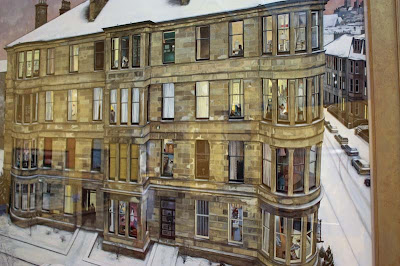It’s A Dot That A Child Could Draw, So Don’t Even Try To Call It “Art”
5 September 2011



 |
| (Source) |
What is art? What makes one piece of work art and another not? What makes a piece of art any good? Ask these questions to any group of people and you can expect a multitude of answers in response. Everyone has different opinions on art, as it is one of the most subjective topics out there – which is one of the reasons it is so hard to be considered a good artist. One person may think your work is amazing; the next may hate it. This makes sitting art exams particularly difficult, as well as having any sort of art-related career.
I think that we are surrounded by a variety of art in different forms (everything from poster designs to architecture to fashion) and you don’t have to be an artist to use art in your career, but the most subjective form is traditional, expressive art, such as paintings and sculptures. I feel some of the key elements in art are creativity, skill and meaning, and after seeing more and more art throughout my life, I have developed strong opinions on each.
While thinking about art, the first thing I realised was that creativity is important to make the work unique to the person who made it. I was told from a young age that art is a creative outlet, where you should express yourself and be unique, something I have always believed to be true. An artist should strive to create something original and new, but also personal to his or herself. This can be achieved using different subject matters or painting techniques and materials, in order for the artist to allow us to see the world in his way. It should be some sort of opening into his mind, which is something unique to everyone, and a good artist should express this in his own style in order to interest other people’s own minds. A piece of work can be very realistic and require a lot of skill, but if there is nothing exciting about it, then it is simply a dull piece of work. For example, one of the most common still life subjects is fruit, and many artists have painted incredibly realistic pictures of fruit, but to me, there is nothing interesting about fruit on its own. However, if the artist uses a creative style to paint the fruit, or comes up with a more unique way to use the fruit in his painting, then for me, it becomes a much better piece of work. Similarly, the composition and style of a piece can be very simple, but if the subject is something interesting, for example using places or creatures that come entirely from the artist’s imagination, or real objects that aren’t commonly used in paintings, then the work itself is more intriguing as well. I find that unusual artwork is always far more interesting.
Over the years, I’ve seen plenty of modern art, which has made me question the skill of such artists. Modern art pieces are unusual and creative, but seem to require very little skill to produce. There is no true talent evident, and anyone could be an “artist” by producing pieces like these. For example, much of the work in London’s Tate Modern is very unique, but a lot of it could be produced by anybody, such as paintings that appear to me as splatters of paint. I think these paintings are bright and fun to look at, but I wouldn’t call them good art, because I feel anybody could reproduce them easily, so I wouldn’t pay money to see or buy them. Other pieces I don’t like are sculptures that don’t seem to resemble anything at all and are made of bits of junk or are just strange twisted shapes. Again, they are unique, but I don’t see any skill involved in a lot of them, and I certainly don’t see how pieces that students make like this earn degrees when people who are very talented at drawing don’t even get into art schools. Also, as well as not needing much skill, I think there are a lot of pieces that don’t require much imagination either, which are therefore not really art in my opinion. I think that art requires true talent, or anybody could be an artist, and some artists are trying to fool people into thinking they’re more talented than they really are, which is something that greatly annoys me.
Another big issue that lies within opinions on art is the purpose of it. Design always has a clear purpose: for example, products are designed for use, fashion is designed to wear and graphics are designed to advertise. Expressive art, however, doesn’t have such a clear purpose, something I’ve noticed when asked to write about pieces for school work. The artist obviously uses it to express himself, but if he needs to sell his paintings commercially to make a living, then that must become its purpose. Some artists don’t mind altering their style to suit public demand, while others will always stay true to their own style, no matter what else. Others think art must carry some sort of meaning or message. Personally, I think art should be whatever the artist intended it to be. If he wishes to give the piece a meaning or story, then that should be his own choice, and if other people like his work and want to buy it, then that is a good thing, but not essential. No one can make a piece of art that suits everyone’s taste, but it will probably appeal to somebody. To me, expressive art doesn’t need a clear purpose in the way design does – it should be about expressing and enjoying oneself. Sometimes, I see meaning in pieces of art which can be quite intriguing, but there are other pieces that I don’t really understand, but I like anyway because of how they look. I’ve realised that meaning in art can be interesting, but I don’t think it is as important as creativity and skill, both of which I feel these pieces have.
A few years ago I visited the Salvador Dali museum in Florida. A whole place dedicated to one man’s art, strange paintings of fantastical and impossible people, places and objects, yet all look incredibly realistic and told stories of his life and gave an insight to his mind. I found his work a little bizarre and creepy, but on the whole, fascinating and unique. It was unlike any other paintings I’d seen, and his skill was evident throughout every piece. His work is famous worldwide today, yet this man was expelled from the School of Fine Arts in Madrid shortly before his final exams. Salvador Dali has become one of my favourite artists, because I feel his work combines creativity and skill exceptionally well. Dali was part of the Surrealist movement, which was known for the way its artists painted real objects, but in an unreal style or composition, which made their paintings very unusual though slightly sinister. For example, Dali is most famous for his melting clocks – clocks are real, but they don’t melt in the way he painted them. He also transferred his ideas to sculptures, including a lobster telephone and soft clocks made of bronze and glass, which shows his range of skills. In my opinion, it takes great imagination to dream up these strange images, but he also painted them incredibly realistically and his paintings were very intricate and detailed. Not only does it take great talent to paint objects as realistically as Dali, but to paint them when he was mostly working from his own head (i.e. he wasn’t copying something or someone right in front of him) and maintain this standard of painting is really amazing to me. His work is unique and completely his own.
I’ve found that another style of art I like is Impressionism, and the most famous Impressionist was Claude Monet (painting above is his). The Impressionist style of working was about capturing the general atmosphere and feeling of what they were painting (an “impression” of it), rather than focussing on all the details. They were also the first artists to paint outdoors, so many paintings feature a lot of very beautiful nature in them. The Impressionist style is much looser and vaguer than Surrealism, but their paintings are full of life and colour, and usually had a happier, more tranquil feel than the Surrealism, which was quite sinister. One of my favourite parts of Impressionism is the way they capture one moment in time, by transferring the atmosphere to the canvas, rather than the exact look of what they’re painting. I feel this is much more effective, as the feelings of the moment will never be quite the same again, even if the object or place looks the same. Expression is the core of art, and this is what the Impressionists tried to do. Their style was creative though not altogether realistic, but still took a great deal of talent to produce. Impressionism and Surrealism are very different, but I like both of them, though for slightly different reasons.
There are many different opinions on what art is and why we create things, and I understand this. Some people see meaning, creativity and skill in works that others don’t, and everyone has their own personal taste in the art they like and what they consider to be art – this can be seen in everything from people’s clothing choices to the design of their homes, as well as what sorts of paintings they like. I wouldn’t criticise someone for the style of art they like, as it is a personal choice, and I wouldn’t criticise an artist for simply expressing himself, however I do have my own taste in art as well. For me, a piece of good artwork has to combine creativity and imagination with some sort of real skill and talent, and this is something that I always try to achieve when doing my own artwork. Although I do art for my own enjoyment, I’m very critical of my own work, particularly when I feel it is lacking one of these elements. This combination of creativity and skill can result in a wide variety of styles, as seen by my own liking of both Surrealism and Impressionism, which are very different, but I like them both anyway. These are also the aspects of art I think should be taken into most consideration when grading someone’s artwork, although I understand that this will always be a very subjective area. But this is all just my personal opinion.
You May Also Like

Why You Should Do Things Solo
26 March 2015
Outfit of the Day – Easy Breezy
28 April 2014
